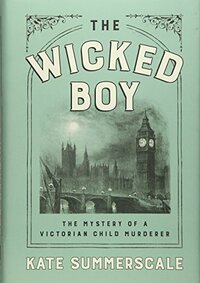Take a photo of a barcode or cover
I loved Summerscale's The Suspicions of Mr. Whicher and think her writing is crisp and her ability to dive into the world of her subjects is amazing. Yet this time around I just could not find my way in to her main subject: Robert Coombes who, at 13, murdered his mother and let her body rot for nearly two weeks. It's because, despite Summerscale's epic digging, much of the crime and Robert--and his brother Nattie, whom she hints more than once may have been way more involved and even an instigator to the crime--remain elusive. There's never a clear motive, just speculation, and there's no real insight into Robert--maybe his Penny Dreadfuls played a role, maybe not; maybe his mother was so emotionally and physically abusive that he snapped, maybe not. Her forays into the British legal system and especially into Broadmoor Asylum were more compelling for sure.
Her epilogue and Robert's later life were also interesting, but the true subject here, the crime and how this "wicked boy" could have done it, never really come together.
Her epilogue and Robert's later life were also interesting, but the true subject here, the crime and how this "wicked boy" could have done it, never really come together.
challenging
dark
emotional
reflective
sad
medium-paced
This felt like the longest 300 page book I've ever read. I enjoyed it, but it's no Devil in the White City. I felt like Summerscale was sometimes so detailed in her research that I got lost in the minutiae. She's a good writer and I respect her research dedication, but I sometimes felt like things could have flowed a little more smoothly.
emotional
informative
medium-paced
Such an interesting book. The crime was fascinating stuff, and then the trial. But it was the part AFTER Robert Coombes was released that really got me thinking. Glad I read this one to the end.
dark
informative
medium-paced
dark
emotional
hopeful
informative
slow-paced
Though slow, I found this book to be quite interesting. I am a fan of true crime but don’t usually hear about crime in late 1800s London. It was intriguing to hear about how the time of the murder affected the outcome and to see the redemption arc.
Graphic: Body horror, Gore, Death of parent, Murder, War, Injury/Injury detail
Wickedly well researched Victorian time capsule. Kate Summerscale should teach a master class on historical true crime.
I received The Wicked Boy as an advance review copy from NetGalley in exchange for an honest review. The book will be released in July. Put it on your "to read" list now.
The Wicked Boy is a non-fiction look at what happened on July 8, 1895, in East London. Robert Coombes, age 13, and his brother Nathaniel, age 12, left the house to go watch a cricket game. They also left the body of their mother, dead, in her room. One of the boys killed her. They may have conspired to plan her death. The reason may have been her mistreatment of them or the elder brothers need for money to run away and have adventures. There are many "may" statements in the first half of this book.
The first half of the book deals with the murder, the trial and the attitude of the boys during all of those events. What is so striking and still resonating through my mind, is the boys' attitudes and lives before the end of the trial and after. If, as soon by their later lives, the murder was an aberration, a one time event, what led to the murders? It really is a fascinating book. Ms. Summerscale did an unbelievable amount of research to detail the lives of all involved. The epilogue contains one of those very rare moments of serendipity that researchers rarely have. For Ms. Summerscale and the reader, it was a satisfying conclusion to the question of the wickedness of Robert Coombes.
The Wicked Boy is a non-fiction look at what happened on July 8, 1895, in East London. Robert Coombes, age 13, and his brother Nathaniel, age 12, left the house to go watch a cricket game. They also left the body of their mother, dead, in her room. One of the boys killed her. They may have conspired to plan her death. The reason may have been her mistreatment of them or the elder brothers need for money to run away and have adventures. There are many "may" statements in the first half of this book.
The first half of the book deals with the murder, the trial and the attitude of the boys during all of those events. What is so striking and still resonating through my mind, is the boys' attitudes and lives before the end of the trial and after. If, as soon by their later lives, the murder was an aberration, a one time event, what led to the murders? It really is a fascinating book. Ms. Summerscale did an unbelievable amount of research to detail the lives of all involved. The epilogue contains one of those very rare moments of serendipity that researchers rarely have. For Ms. Summerscale and the reader, it was a satisfying conclusion to the question of the wickedness of Robert Coombes.
dark
medium-paced





